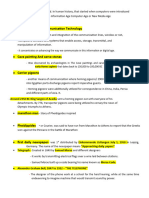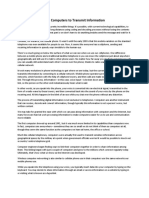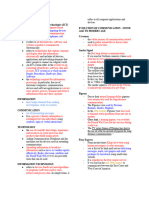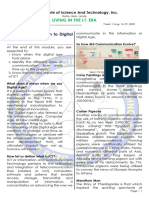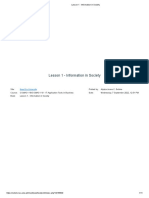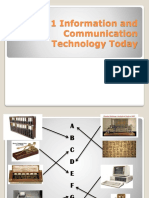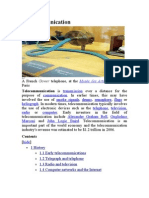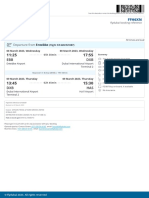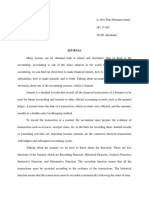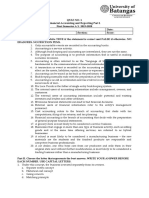TOPIC 4: INTRODUCTION TO COMMNUNICATION TECHNOLOGIES I
By the end of this topic, you should be able to:
1 define the term, communication, data communication, telecommunication and network
2 trace the history of the telephone, cellular and internet communication technologies
3 outline the uses of networks
4 state the elements of communication systems
DEFINITIONS OF TERMS
1. Communication
Communication refers to the process of transmitting and receiving information between two or more
people in a commonly understandable way.
2. Technology
This is the application of science to invent useful things or to solve problems especially for industrial
or commercial objectives.
A product such as a machine, equipment or a method that is created by technology is also referred to
as technology.
Technology has increased efficiency in communication.
3. Data communication
Data communication is the electronic transmission of data encoded digitally for storage and
processing by computers.
It can also be defined as an exchange of data using existing communication networks.
COMPONENTS OF DATA COMMUNICATION
a. Message: this is the data or information to be communicated.
It can be in form of pictures, text, videos, sound or any combination of these.
b. Sender: this is the device from which data message originates.
It can be a computer, workstation, telephone handset among others.
c. Receiver: this is the device that accepts or collects the message.
It can be a computer, workstation, telephone handset, television among others.
d. Medium: this is the physical path by which a message travels from the sender to the receiver.
It may be a twisted –pair cable, coaxial cable, fiber optic cable, radio waves or laser beam.
e. Protocol: this is the set of rules that govern data communication.
It represents an agreement between the communicating devices.
Without the protocol, two devices may be connected but not communicating.
The illustration below shows the components of data communication;
Medium Message Medium
Protocol Protocol
1|Page
�4. Information Technology (IT)
This refers to the use of computers to collect, store, disseminate and manage information.
It substitutes manual methods of keeping large volumes of data in files, physically transporting them
from one point to the other. Nowadays this is done by computers in a network.
5. Communication technology
It is an activity of designing, constructing and maintaining communication systems.
In the modern era it is referred to as Information and Communication Technology (ICT).
6. Telecommunication
Telecommunication is the process of transmitting and receiving information between two or more
people over long distances.
Transmission can be through radio waves, electronic or optic signals
7. Network
A network is an interconnection of computers and other computer-like devices that work together to
exchange information and other resources.
HISTORY OF TELEPHONE, CELLULAR AND INTERNET COMMNUNICATION TECHNOLOGIE
The world nowadays is known as global village due to increased means of communication such as telephone,
cellular phone and internet.
a. History of Telephone
o A telephone also known as a phone is a device that sends and receives voice messages and data.
o It converts speech and data into electrical energy, which is sent over great distances/
o The history of invention state that number of inventors contributed to a technology of carrying voice
signals over long distances.
o In 1854, the French inventor Charles Bourseul suggested that vibrations caused by speaking into a
flexible disc or diaphragm might be used to connect and disconnect an electric circuit. This would
produce similar vibrations in a diaphragm at another station where original sound would be reproduced.
o A few years later, the German physicist, John Philip Reis invented an instrument that transmitted
musical tones but it could not reproduce speech.
o In 1860 Antonio Meucci an Italian American developed an acoustic communication device that could
transmit speech.
o However, the first to achieve commercial success and inaugurate widespread use of the telephone was a
Scottish-born American inventor Alexander Graham bell. He was a speech teacher in Boston,
Massachusetts.
o Therefore, Bell is considered as the person who invented the first telephone.
Alexander Graham Bell speaking on his phone One of the early telephones
2|Page
� o By 1884, long distance connections had been made between Boston, Massachusetts and New York
city.
o However, Bell did not imagine that telephone lines could be used for transmitting video images.
o After Bell`s death in 1922 the telecommunication industry has undergone an amazing revolution till
today
A telephone switchboard.
b. Cellular
o A cellular is a portable device that can make and receive telephone calls over a radio link while moving
a wide geographic area.
o It is also known as a cell, cellular phone cell phone, mobile phone or portable phone.
o Like a telephone, it enables people to communicate almost anywhere in the world.
o It has become very valuable tool to people who want to stay in touch on the move.
Cell phones
o The cellular was invented by Dr. Martin Cooper in 1973 at Motorola, a telecommunication company
based at Schaumburg in Illinois.
o The first cell phone call was done by on April 3, 1973 by team lead by Cooper using a handset weighed
about 1kg.
o However, modern cell phones have drastically changed to smaller size, have LCD to display contacts,
pictures, ringtones, and games and so on.
o Lately, there are cell phones that use touch screens that allow the user to choose options and commands
by touching the screen.
3|Page
�c. Internet
o It is the interconnection of networks liked by various networking devices using protocol suite (TCP/IP)
to facilitate exchange of data.
o Internet was not created by single person.
o However, the initial idea of internet was done by Leonard Kleinrock after he published his first paper
entitled “Information Flow In Large Communication Nets”
o In 1962 J.C.R. Licklider (the director of Information Processing Technology Office (IPTO)) gave his
vision of galactic network.
o Robert Tailor also helped to create the idea of the network by Licklider and Kleinrock. This network
was later called Advanced Research Projects Agency Network (ARPANET)
o ARPANET also written as ARPAnet was created by United State Defense Advanced Research Project
Agency (ARPA).
o It served as a test-bed of new technologies linking many universities and research centers and it was the
beginning of what we consider as Internet today.
o ARPANET first came into existence when the first two nodes were established between University of
California, Los Angeles (UCLA) and Stanford Research Institute (SRI) in 1969.
o This followed shortly thereafter by University of California, Santa Barbra (UCSB) and the University of
Utah.
o ARPANET was replaced by National Science Foundation Network (NSFNET) in 1990.
o NSFNET is a network started by National Science Foundation (NSF) that went online in 1986.
o During 1980`s and early 1990`s, NSFNET was the crucial backbone to ARPANET and Internet.
o In 1990, a British computer Scientist known as Berners-Lee developed HTML (Hypertext Markup
language) which made a huge contribution on how we navigate and view the Internet.
Timothy Berners-Lee
o Internet uses TCP/IP protocol which was created in 1978 to support real time traffic.
o TCP/IP was originally developed by the United States Department of Defense for computers using
UNIX operating system but now it is used by every computer regardless of type operating system on the
Internet.
o Internet is accessed by using a computer modem or network that is connected through an Internet
Service Provider (ISP) such MTL (Malawi Telecommunication Limited) in Malawi.
USES OF NETWORKS
o The core importance of networks are
To share information and other resources such as printers easily.
To run programs on the other computers other than the one they are sitting on.
o Networks are mostly used in the following business applications:
4|Page
� a) E-banking
o It is a short form for electronic banking.
o It is a method of banking in which a customer conducts transaction electronically via internet.
o It is also called online banking or Internet banking.
o A customer accesses his or her accounts from a browser on the bank`s worldwide server.
o A customer registers with the bank to access his/her account. The customer sets up some
password and username for verification.
o To access the account, the customer needs an access of an Internet.
b) Mobile banking
o It is a system that allows a customer of a financial institution to conduct a number of financial
transactions through a mobile device such as mobile phone or PDA.
o With mobile banking, you can carry out transactions such as balance enquiries, money transfer
between accounts, pay utility bills and many others.
o Like with e-banking, in mobile banking, a customer registers with the bank for the service and
set up some username and password for verification.
c) Automated Teller machine (ATM)
o This is a computerized machine the permits bank customers to gain access to their accounts with
magnetically encoded plastic card (ATM card) and a code number.
O It enables the customers to perform several banking operations such as to withdraw cash, make
deposits, pay bills, obtain bank statements and effect cash transfers without the help of a teller.
d) Electronic Point Of Sale (EPOS)
o It is a computerized checkout system in stores or shops that records sales by scanning bar codes.
o It automatically updates the retailer`s stock lists, and provides a printout of the customer`s
purchases.
o EPOS allows for efficient computer stock control and reordering.
o It also provides other financial indicators such as profitability on different lines, stock ratios,
turnover among others.
e) Remote Access
o This means the ability to log onto a network from a distant location.
o It requires a computer, a modem and some remote access software to connect to the network.
o Situations/examples of using remote access:
In corporations, people at branch offices, telecommuters and people who are travelling.
Accessing the Internet at home through Internet Service Provider (ISP)
Dial-up connection through desktop, notebook or handheld computer modem over
regular telephone lines.
Integrated Services Digital Network (ISDN) for example from branch offices. ISDN
combines dial-up with faster rates.
Wireless, cable modem, and Digital Subscriber Line (DSL) also offers some remote
access possibilities.
f) Mobile communication
o It is a communication network (either public or private) which doesn’t depend on any physical
connection between two communications.
5|Page
� o It uses radio waves to carry signals and messages across distances.
o Wireless communication systems include cellular phones, radio telegraphs, satellite, etc.
COMMUNICATION SYSTEMS
o A communication system is a collection of individual networks with the capability of exchanging
information and working together with other networks (interconnection and interoperation).
o The purpose of communication system is to serve a common purpose of effective communication and
operate collaboratively.
ELEMENTS OF COMMUNICATION SYSTEMS
o There are three basic parts:
a) Transmitter
b) Communication channel
c) Receiver
Information Communicat Information
Message Transmitter sent received Receiver Message
source ion Destination
signal signal
Channel
Noise
A simple communication system
a) Transmitter: it is a collection of electronic devices and circuits that encode data or information into
signals for transmission.
o A transmitter may consist of microphone or microwave source.
b) Communication channel: it is a medium through which signals travel from one point to the other.
o It can be physical medium such as fiber optic or wireless medium such as radio waves.
c) Receiver: it is a collection of electronic devices and circuits that decode the received data into
understandable signal.
o A receiver may consist of an earphone or complicated electronic radio receiver.
Noise: it is any unwanted signals (or any disturbance) that interferes the transmitted signals.
o It mixes with transmitted signals when they travel through communication channel.
EXAMPLES OF COMMUNICATION SYSTEMS
1. Telephone.
o In this system, telephone unit of calling party is transmitter.
o Its mouse piece converts sound waves into equivalent electrical signals.
o The waves are amplified and sent over telephone lines (communication channels).
o The telephone unit of the called party is the receiver. The signals from telephone line are received by it
and again amplified. Then are connected to its earpiece.
o Earpiece converts electrical signal into its original sound waves.
6|Page
�2. Radio station system
o The broadcasting station (for example MBC in Malawi) is a transmitter.
o Its microphone converts sound waves (voice of news reader for example) into its equivalent electrical
signals.
o These signals are amplified, processed and sent over antenna tower into space.
o The radio receiver unit at far end is the receiver.
o The signals from the space are received by its antenna and again are amplified and processed, then they
are connected to its speaker there by converting electrical signals into its original sound waves.
7|Page






